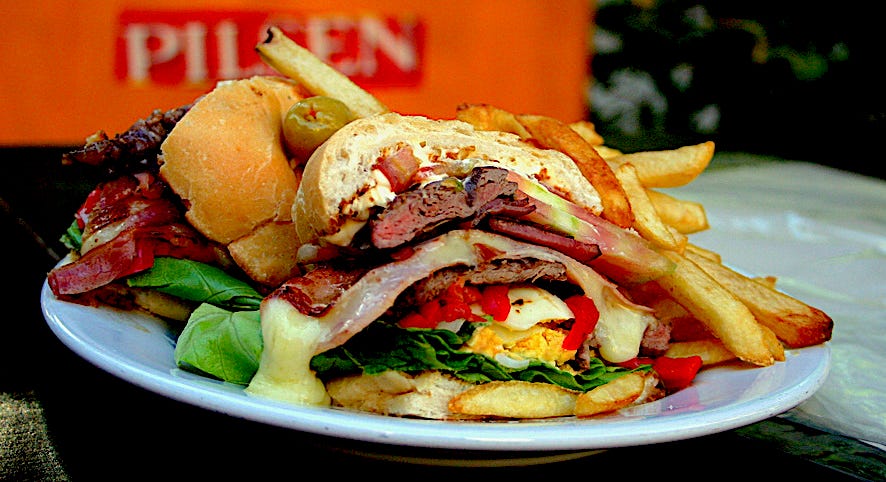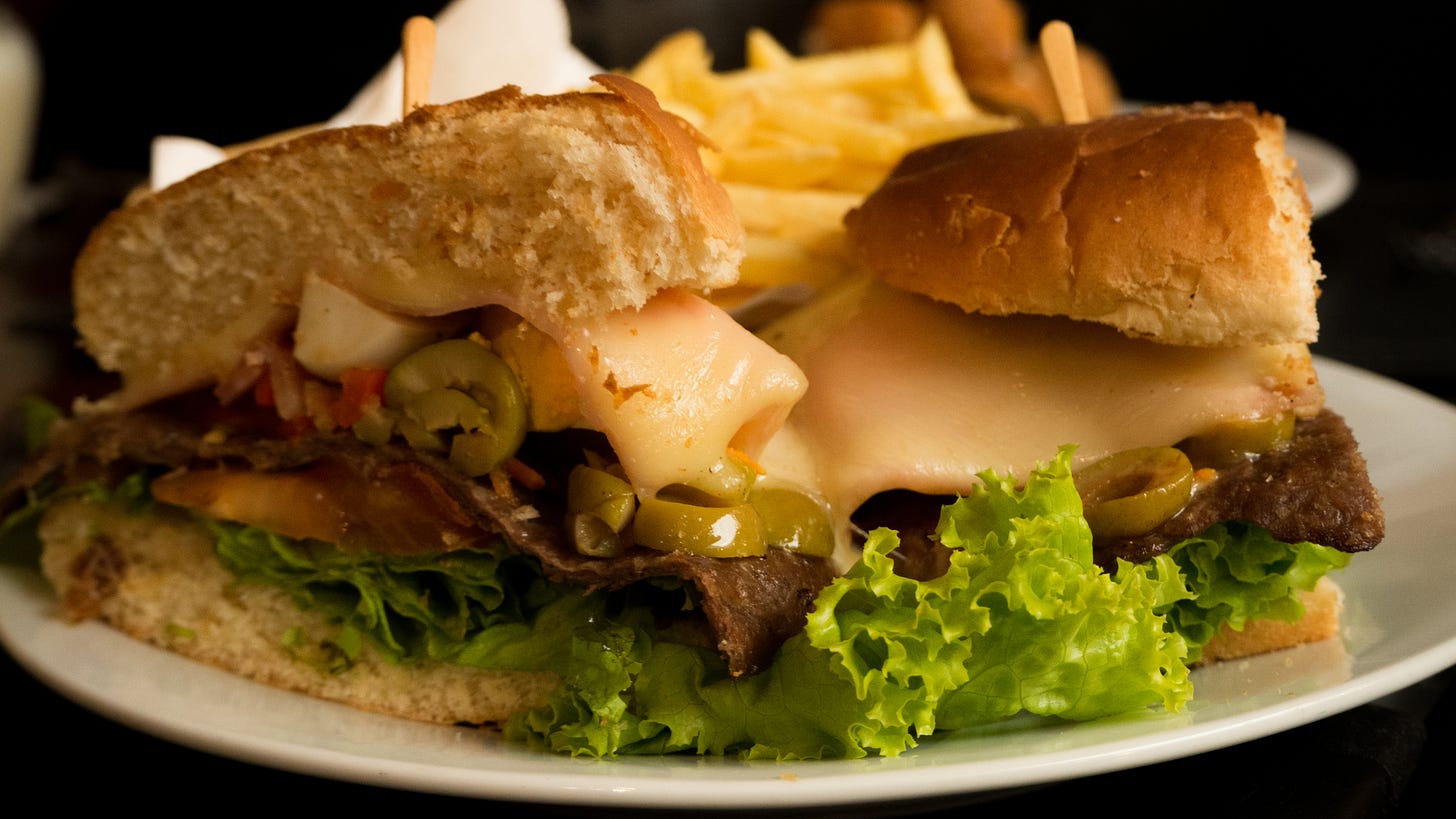Notable Sandwiches #42: Chivito
Alas, Uruguay's G.O.A.T. sandwich is not a goat sandwich
Welcome back to Notable Sandwiches, the feature where I, alongside my editor David Swanson, trip merrily through the strange and ever-shifting document that is Wikipedia’s List of Notable Sandwiches, in alphabetical order. This week: an Uruguayan standard, the chivito.
The chivito is both Uruguay’s national sandwich—if the food blogs are to be believed—and the subject of a classic culinary shaggy-dog origin story. Chivito is also the Spanish word for “baby goat,” though this particular sandwich includes just about every ingredient imaginable except baby goat.
Plenty of chivo—that is, adult goat meat—is eaten in Uruguay, though not remotely as much as beef: the Uruguayan Goat Breeders Association claimed a very modest 10,000 animals as of 2015; in contrast, the country is home to 12 million head of cattle. Like many of its South American neighbors, Uruguay prides itself on its cattle culture: it’s one of the world’s top beef producers, with herds roaming through a country described as “one big farm.” As such, Uruguay’s cuisine is full of bovine sizzle, rising up from the parillas (grills) of Montevideo and Las Piedras. With the highest cow-per-human ratio in the world, Uruguayan cattle outnumber Uruguayan humans three to one (in the U.S., it’s one cow for every 3.5 humans.) So it’s jarring—capricious, even—to see the national dish of such a beefy country named for the wayward goat. Naturally, in many versions of the chivito’s origin, the name is chalked up to the whims of an interloper from Argentina. (This is becoming a familiar sandwich story.)
As documented in the book Chivito: El rey del los sandwiches de carne, by Alejandro Sequeira and Armando Olivera (and as summarized by Melina Fajardo at Culture Trip), on a fateful New Year’s Eve in 1944, a wayward Argentine woman stumbled into the famed El Mejillon restaurant in Punta del Este, and asked for roast goat—preferably a kid, a tender little chivito. (The nameless woman was, according to a different interview with Sequeira, from the mountainous Cordoba region of Argentina, where goat is common fare.)
Not having any goat on hand, the owner—a man named Antonio Carbonaro—turned to the kitchen and slapped together a mountainous sandwich: a quarter pound of steak, a slab of ham, cheese, olives, tomatoes, peppers, hard-boiled egg. Carbonaro gave it to the tourist, calling it a chivito, since it was roughly the size of a goat haunch anyhow. And thus a beloved—and unwieldy—legend of a sandwich was born. Ingredients vary, but steak, ham, cheese and a soft bread like pan tortuga are the core components; tomato, lettuce and mayo adorn the most common iteration, but everything from alfalfa sprouts to Canadian bacon (in the chivito canadiense) crops up between the buns. The consensus seems to be clear on a few central features, however: a proper chevito has to be big (it’s often served as a refuerzo, a big snack—or reinforcement—to tide you over til dinner at 11 p.m.), it has to be savory, and the bread has to give way, yieldingly, to the cheese-robed beef inside.
People often ask me, when feigning interest about what I do for a living—“I write about racism and sandwiches,” I say, crooking up my mouth in a way that I think looks dashing and undoubtedly looks like I’m desperate for a bathroom—if I eat all of the sandwiches that I write about. I have definitely eaten some of them. I live in New York City, where much and more of the world’s cuisine is an UberEats order away. But I’d be lying if I told you that I’d spent night after night tenderly assembling confections of sandwich-craft, sourcing exotic ingredients, and hand-breading croquetas or grinding homemade bologna salad. The sandwich, in my hands, is often theoretical, a jumping-off point to discuss some aspect of colonialism, slavery, cultural appropriation, and the way these things make their way onto our plates. In this case, the chivito hung over my week, offering visions of soft Uruguayan bread yielding before a melting slab of mozz, but I didn’t even try to source one. I was too busy being on a fucking diet.
Having spent entirely too much time over the past thirteen days discussing, thinking about, bemoaning, blaming, and obsessing over this fucking diet, I’m loath to do it further here. Suffice it to say that I got a medical test result that scared me awhile ago, and decided to Do Something About It, and like tens of millions of Americans before me got gulled by the assurances of a guru-led program full of pseudoscience and “tough love.” The program, called the Whole30, is supposed to magically ameliorate any number of ailments (autoimmune disorders, back pain, various inflammations, diabetes, etc…) by encouraging its proponents to cut out all sugar, all grains, all legumes (including soy and soy derivatives,) all dairy, and all alcohol. What remains is vegetables, meat, seafood, nuts and water. Hypothetically, I suppose I could have consumed chivito Argentino and stayed within the rules, but chivito Uruguaiano was out of the question.
And I really threw myself into this thing—tossing out perfectly good food because, on second examination, it had “less than 2% dextrose”; making mayonnaise by hand because Hellman’s contains soybean oil; like Popeye, consuming full bags of spinach in a sitting; and … lapsing into an absolute black pit of depression, anger and lethargy. I sniffed a challah loaf and patted it gently but didn’t eat it, and went to sleep feeling a vague sense of shame. I started pinching at my body, wanting to winnow it, to be virtuous and pure and never even think about the marvelous temptations of lima beans. The fatigue was so intense I didn’t want to get out of bed (“you have walked 75 steps today,” my phone chirped at me yesterday), I was enraged and embittered and on the verge of tears half the time, and I was supposed to take this as (in the cutesy phrase of the Whole30 materials) just a passing case of “carb flu.”
The Sword and the Sandwich is a newsletter about serious extremism and equally serious sandwiches. Please consider supporting this work with a paid subscription:
Maybe it would have passed! I wouldn’t know. I decided that life is too short for this bullshit, and tonight I had some rice. I didn’t manage to secure a chivito, but the thought of biting into a piece of bread is actively making me salivate on my keyboard. One interesting aspect of the Whole30—like other extremely restrictive food programs—is that it is painstaking about telling you how much it is Not A Diet while peppering all its material with effusive testimonials that foreground weight loss. Another thing that is interesting about the Whole30 is that it’s absolute woo-woo gobbledygook (there is nothing wrong with carrageenan! Or MSG!) so confidently expressed and so full of promises that if you’re scared or ashamed or both, it’s easy to want to be told what to do in a firm voice by a white woman with good hair. It’s only a month, right? What’s the problem with being sad, and cruel to people you love, and absolutely disgusted by the thought of food … for a month? Once thirty days have passed, you’ll be so much smaller! Think about how much smaller you’ll be if you take away the things you love to eat and think, all the time, instead, about the rules.
I’ve tried to be savvy and avoid the many, many landmines of internalized fatphobia and the endless hideous cycle of yo-yo dieting (losing forty pounds last year with calorie restriction and exercise, only to gain seventy back after catching a bad case of covid was a sharp lesson). Diets don’t work! They don’t work, and they’re all lying about not being diets. They’re not Lifestyle Improvements or Health Programs or Magical Healing Cleanses. They are diets, with associated books and supplements and products usually, vastly expensive, impractical, and incredibly difficult to maintain for any period of time; and I hope someone smacks me across the face if I ever again forget one cardinal rule:
In the end, anyone who deprives you of a sandwich is probably not on your side.
There are many ways to respond to fear, and one of them is to appeal to authority, to let oneself be led, even if the path is strewn with nonsense. That is a fundamental truth I write about all the time with regards to fascist movements, but it’s true of diet culture as well, with the extra spice of channeling, supercharging, and monetizing self-loathing.
Caught in and spat out by that very familiar and very American gale, I spent two weeks lost in the mountains of melancholy, the crater of confusion, the abyss of apathy, and other shitty geographical features of the carbohydrate-deprived: the Doldrums, say. I return, like an Argentine of Cordoba, to the chivito, contemplating its glorious heaped wantonness: about the way pan tortuga is shiny and milk-enriched, briochey and glorious; about Canadian bacon and thin-sliced tenderloin. And I hope I can find my way back to health (note: not determined by the size of my belly or ass) sooner rather than later—but on a path that doesn’t require fanatical abstention, obsession, self-hatred, and so many goddamn eggs. I hope that in the interim I can eat something soft and warm and sustaining, a refuerzo for the soul, a chivito for all my ills.









Once again a brilliant melange of history, gastronomy and sociology! As much as I enjoy the times I feel fit and 'healthy', any food plan that disallows fruit and the occasional (ok, nightly...) glass of god's own grape, will never be an option for this (mostly) happy old granny.
Diet culture is eugenics adjacent and you know where that leads. Do not diet. Ever. Eat. Eating is a form of self love. You deserve to love yourself.